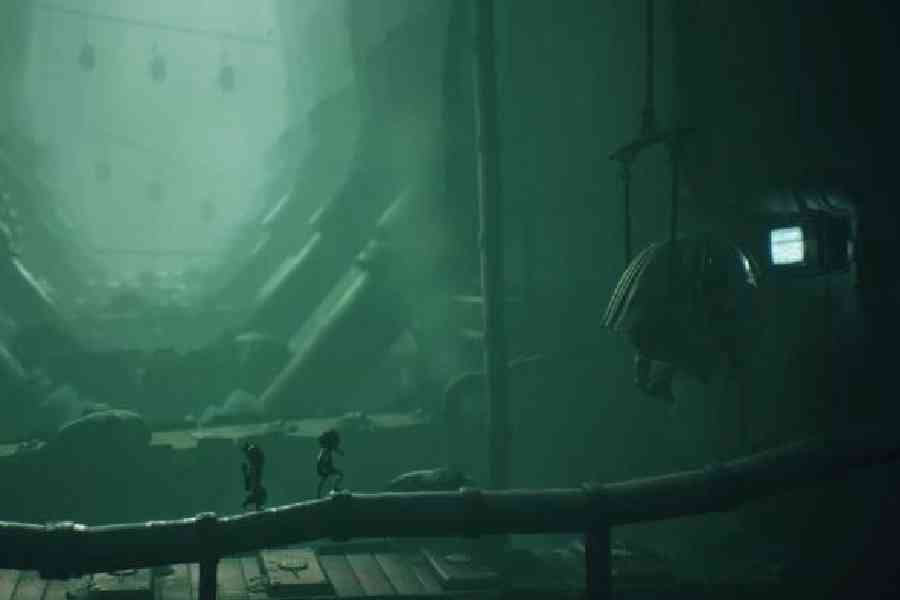An irascible clerical worker with spidery limbs. Forlorn labourers at a carnival who turn one of their own into a piñata. A towering baby with a searchlight for an eye.
These are a sampling of the sights in the tastefully morbid Little Nightmares III, a game that forgoes run-of-the-mill jump scares, excessive gore and the other emblems of outright horror for the series’ trademark atmospheric creepiness.
The first Little Nightmares (2017) struck me as one of the best side-scrolling adventure games to hit the market since the genre was reinvigorated by Limbo (2010), which combined the aesthetics of silent film with the endangered-child theme of a European fairy tale. Little Nightmares told the story of a girl named Six who traverses a resort filled with skincare-lacking grown-ups who’d like to nibble on her.
In Little Nightmares II (2021), players took on the role of Mono, a young boy who, together with Six, tries to locate the source of a mysterious signal that keeps city inhabitants enraptured before their television sets. It closes with one of the more haunting endings of any game I’ve ever played.
Little Nightmares III doesn’t quite hit the same high notes as its predecessor, a stranger and ultimately less predictable entry. Even so, I thoroughly enjoyed playing through
it twice: by myself, and with a friend. Certain sections require the use of the two main characters’ special abilities: Low can use his bow to shoot at buttons too high up for
him to push, while Alone can use her wrench to smash through partially damaged walls.
The game opens in inky darkness before a gilt-framed mirror swirls into view, revealing a room with a window. The scene then cuts to Low lying on the floor in a room that looks like a ship cabin; behind him stands a shattered mirror. Upon startling awake, he is approached by Alone, who gently offers him her hand. Together, they set out and soon emerge from the steel interior into a luminous, orange-hued desert — the graveyard of a dead civilisation.
This gorgeous, unexpected transition is a callback to the opening of the first game, which saw Six emerge from what appeared to be a ship into an incongruous space absent of water.
The two will journey from the desert to a candy factory, carnival and asylum. Gameplay is divided among light puzzles, chase sequences and brief combat encounters.
My friend and I did run into a couple of frustrating sequences where a running jump was required and we watched our feet bounce off the edge of an object. But those moments were exceedingly rare. The puzzles are clever and legible. Combat sequences are short. Thank goodness for a horror game that privileges flow over grindy challenges.
Coralie Feniello, the global producer on Little Nightmares III, which was developed by Supermassive Games, emphasised the game’s “charming horror” that juxtaposes the cuteness of children with a disturbing world. It visually employs a lot of round shapes to tease out this cuteness, she said, before developers break it at certain points to create disturbing tension.
The studio’s overarching strategy was to think about the setting for a puzzle first. “You really want to have the aesthetic serving the gameplay, not the reverse,” she said.
Two small moments perfectly capture exactly what I enjoyed about Little Nightmares III’s approach.
In one room, the children come upon a puppet that is chained to a pipe. Low can use his arrow to shoot the puppet’s head off, and then Alone can use her wrench to smash its skull to reveal a key. This dynamic is later built upon for a memorable combat encounter.
Elsewhere, when the children reach a candy factory, they must wade through a landfill full of discarded sweets. As they do so, the camera pulls back to reveal an ominous mechanical claw, dumping yet more candy onto the dunes of refuse. The droning sound effects suggest there is something very important about the contraption, but there isn’t.
It’s not Chekhov’s claw. The scene exists purely for its atmospheric quality.
Such moments go a long way to immersing players in a world that is not always clamouring for them to do something. Feniello said the development team internally referred to the game’s point of view as a “dollhouse camera” because players experience the world like gazing from a distance through a window.
“Each room is kind of a portrait, like a painting,” Feniello said. “Each room says something about the world.”










